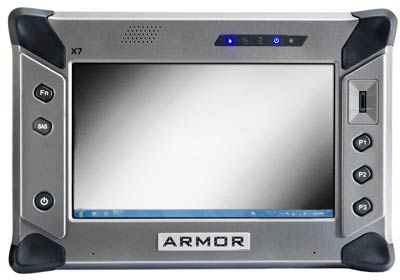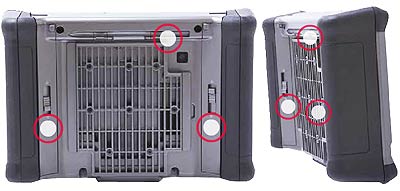|
DRS ARMOR X7
Compact rugged tablet offers versatility and almost limitless expansion potential
(by Conrad H. Blickenstorfer)
On January 13, 2011, DRS Technologies, a Finmeccanica company, announced that its Tactical Systems Group had unveiled its newest ARMOR rugged mobile computer. The new ARMOR X7 is a compact tablet designed specifically for mission-critical tasks that require a combination of connectivity, handheld mobility, ease of use, and enough ruggedness and durability to support all-weather operations.

Note that the ARMOR X7 is very specifically not another sleek tablet seeking to do battle with the almighty iPad. Instead, it is a true-blue vertical market industrial tablet computer built on two decades' worth of experience in creating nearly indestructible tablet computers. For that's what the folks at DRS Tactical, formerly known as WalkAbout, are famous for. For proof look no farther than the company's ARMOR X10gx tablet that's now in its 10th generation (see full review here).
So how did DRS Tactical go about making a smaller tablet? A bit differently from how they make the big X10gx.
First, they used a composite housing over a magnesium frame, with rubber overmolds for extra protection and ergonomics. That's compared to the X10 being essentially all magnesium-alloy inside and out. Composite is lighter, of course, and between that and the X7's smaller dimensions (8.9 x 5.9 x 2.1 vs. 11.4 x 8.6 x 1.8 inches), the X7 weighs only half as much, about 2.85 pounds.
Second, the X7 is based on Intel Atom technology, but not the Z-Series generally used in industrial tablets. Instead, DRS chose the 1.66GHz "Pineview" Atom N450, a second generation Atom processor with integrated graphics. The N450 is the chip that replaced the Atom N270 that powered, and continues to power, tens of millions of netbooks. It's a reliable, frugal solution that provides enough performance to swiftly run Windows 7, and one that generates so little heat that with careful thermal design, there's not even need for a fan (the X7 doesn't have one).
As the X7's name probably implies, the device has a display that measures 7 inches diagonally and uses the 1024 x 600 pixel WSVGA resolution popularized by all those millions of first gen netbooks. Of note is that the X7 offers auto-sense dual mode digitizer and resistive touch, which means you can use a pen when you need precision, and a stylus or finger when you don't. That's a very useful feature to have. There are also three programmable function buttons for one-touch access to often-used apps. According to DRS, the display has anti-glare and anti-reflective treatment and is fully sunlight readable.
Specs indicate that the X7 is remarkably well connected and also very configurable. While externally you only find a mini USB port and a power jack, there's a user accessible "FlexSpace" bay with an open-source interface that can support 3rd party or application-specific functions. There's also a PCIe socket, a SIM card socket, two USB 2.0 ports, an RS232 pPort, and +5V/+3.3V power for active modules. There is further an expansion bay with two USB 2.0 ports, RS232 serial, as well as power for modules. We have not seen that expansion arrangement yet and will report on it in more detail once we have an eval unit.

For wireless, there's the usual 802.11a/g/n and Bluetooth, and you can get optional Gobi 2000 for wireless technology and carrier independence, as well as GPS. A 2-megapixel camera and fingerprint scanner are also present.
As you'd expect, the ARMOR X7 is an exceptionally rugged device. Light weight, tough materials, rubber bumpers, and exemplary design (and the use of an Intel solid state drive instead of a hard disk) combine to allow the X7 survive six-foot drops to concrete, as measured via MIL-STD-810G, Method 516.5. The operating temperature range is an exceptionally wide -4 to 140 degree Fahrenheit. Sealing is at the IP65 level, which means the X7 is dustproof and can handle low pressure water jets from all directions (albeit with "limited ingress permitted," which we don't like to see).
Judging by the specs and pictures, the X7 represents a very valuable addition to the ARMOR line of rugged tablet computers. The small screen size and the lower performance level of the Atom processor platform present deployment limits, but if those limits are not an issue, then the smaller size and low weight (and presumably lower price) of the ARMOR X7 make it a perfect solution for many field applications.
|
|
|
|
Specifications
|
|
Added/changed
|
Added 01/2011
|
|
Form-factor
|
Compact rugged tablet
|
|
Processor
|
Intel Atom N450
|
CPU Speed
|
1.66 GHz
|
|
Chipset
|
Embedded Luna Pier system architecture and ICH8M I/O controller hub
|
Standard/Max RAM
|
2GB 667MHz DDR2 SDRAM
|
Disk/drive
|
40GB Intel 310 Series solid state disk, 80GB optional
|
Card slots
|
SDHC card, "flex-space" bay
|
Display type
|
Transmissive sunlight-readable TFT with LED backlight, anti-glare and anti-reflective treatment and auto light sensor
|
Display size/res
|
7.0-inch/1024 x 600
|
Digitizer/pens
|
Auto-sense dual mode digitizer and resistive touch
|
Keyboard/scale
|
Onscreen and optional external
|
Drop spec
|
6-foot drop (MIL-STD-810G, Method 516.5)
|
Sealing
|
IP65
|
Operating temp.
|
-4 to 140 degree Fahrenheit
|
Humidity
|
up to 95%
|
Altitude
|
20,000 feet
|
Vibration
|
30g, 11ms, half-sine operational shock
|
Hazardous location
|
ISAFE: UL 1604 Class I, Division 2, Groups A, B, C and D; CSA C22.2 No. 213-M1987; EN60079-0, EN60079-15:2005 (ATEX), ESD 22 kV air
|
Certifications
|
TUV, CSA, FCC Part 15, CE Mark, E-Mark, C-Tick, Energy Star, EPEAT (Gold Level), I-SAFE/ATEX
|
Housing
|
Composite housing, magnesium frame, and rubber overmold
|
Size (WxHxD)
|
8.9 x 5.9 x 2.1 inches
|
Weight
|
2.85 lbs.
|
Power
|
Twin hot-swappable Lithium polymer battery packs (2950mAh 2 cell packs each); optional 4 cell ( 5900mAh each, 9+ hrs) battery packs
|
Interface
|
USB-mini, dock, power, 2 RF, fingerprint scanner, 2mp camera; Expansion Bay: 2 USB 2.0, RS-232; FlexSpace: PCIe socket, SIM Card, 4 GPIO, 2 USB 2.0, RS-232, RGB video, HD audio
|
Wireless
|
802.11a/g/n, Bluetooth v2.0 + EDR (Class 1); optional integrated GPS, integrated Gobi WWAN module
|
List price
|
Inquire
|
Contact
|
DRS ARMOR
|
Brochure
|
DRS ARMOR X7 brochure
|
|
|
Search
|
|
|
|



